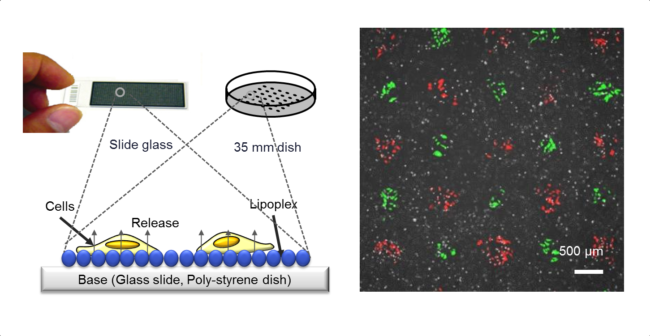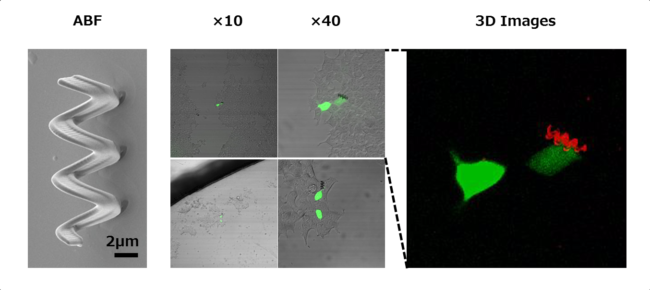RESEARCH
Transfected Cell Microarray

One form of cell microarrays, the transfected cell microarray (TCM), on which plasmid DNA or siRNA, spotted on the surface of a substrate, is reverse-transfected locally into adherent cells, has become a standard tool for parallel cell-based “omics” analysis (cellomics). The construction of TCMs of high density is should have particular relevance to medical applications.
Reference:
1) Yamada, S. et al., (2009) Biosens. Bioelectron., 96, 1493-1497
2) Yamada, S. et al., (2008) Neuroreport, 19, 1733-1738
3) Fujita, S. et al., (2007) J. Biosci. Bioeng., 96, 329-333
4) Yamada, S. et al., (2007) Biochem. Biophys. Res. Commun., 363, 926-930
5) Yamada, S. et al., (2007) Neuroreport, 18, 359-363
6) Yoshikawa, T. et al., (2004) J. Control Release, 96, 227-232
High dense TCM
The medically relevant exploitation of most current TCMs remains limited because of cross contamination of arrayed reagents and the migration of cells. Currently, it is usually necessary to maintain a distance of 500 μm or more between microspots on a TCM. For higher-density microspots, methodological breakthroughs are required to prevent the migration of cells and to limit the diffusion of spotted materials among the micro-spots in the array.
Reference:
1) Fujita, S. et al., (2013) Lab Chip, 13, 77-80
2) Hakamada, K. et al., (2010) J. Biosci. Bioeng., 109, 62-66
Cell Microarray for Detecting Cell Migration
 |
Cell migration plays a major role in a variety of biological processes and a detailed understanding of associated mechanisms should lead to advances in the medical sciences such as drug discovery for cancer therapy. However, screening of genes by “classical” methods can be complicated by factors related to the stimulation of cells. In this study, we have attempted to develop a novel simple method by transfection microarray-based cell chip for the genome-wide screening of genes involved in cell migration.
Reference:
1) Onuki-Nagasaki, R. et al., (2015) BMC Genet., 16:9
2) Enomoto, J. et al., (2014) Sens. Actuators B Chem., 190, 896-899
3) Onuki-Nagasaki, R. et al., (2008) Lab Chip, 8, 1502-1506
Micromachine for 1cell DDS (collaborate with Prof. Nelson in ETHZ)
 |
The Artificial bacterial flagella (ABFs) were functionalized by lipoplex including plasmid DNA. The f-ABFs are steered and controlled wirelessly by low-strength rotating magnetic fields and plasmid DNA into targeted 1 cell in vitro.
Reference:
1) Qiu, F. et al., (2015) Adv. Funct. Mater., 25, 1666-1671
2) Qiu, F. et al., (2015) Sens. Actuators B Chem., 196, 676-681
